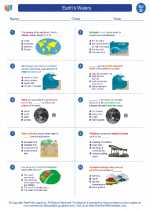Earth's Waters -> symbiotic relationships
Symbiotic Relationships
Symbiotic relationships are interactions between two different species that live closely together. These relationships can be beneficial, harmful, or neutral for the species involved.
Types of Symbiotic Relationships
There are three main types of symbiotic relationships: mutualism, commensalism, and parasitism.
Mutualism
Mutualism is a symbiotic relationship in which both species benefit from the interaction. For example, bees and flowers have a mutualistic relationship - the bees get nectar from the flowers, and the flowers are pollinated by the bees.
Commensalism
Commensalism is a symbiotic relationship in which one species benefits while the other is unaffected. An example of commensalism is the relationship between barnacles and whales - barnacles attach themselves to the skin of whales and benefit from the transportation and food particles stirred up by the whales, while the whales are not affected.
Parasitism
Parasitism is a symbiotic relationship in which one species benefits at the expense of the other. Parasites obtain nutrients from their host, often causing harm or disease. An example of parasitism is the relationship between ticks and mammals - ticks feed on the blood of mammals, which can cause harm to the host.
Study Guide
- What are symbiotic relationships?
- What are the three main types of symbiotic relationships?
- Provide an example of mutualism.
- Give an example of commensalism.
- Describe parasitism and provide an example.
◂Science Worksheets and Study Guides Fourth Grade. Earth's Waters

 Worksheet/Answer key
Worksheet/Answer key
 Worksheet/Answer key
Worksheet/Answer key
 Worksheet/Answer key
Worksheet/Answer key
 Vocabulary/Answer key
Vocabulary/Answer key
 Vocabulary/Answer key
Vocabulary/Answer key
